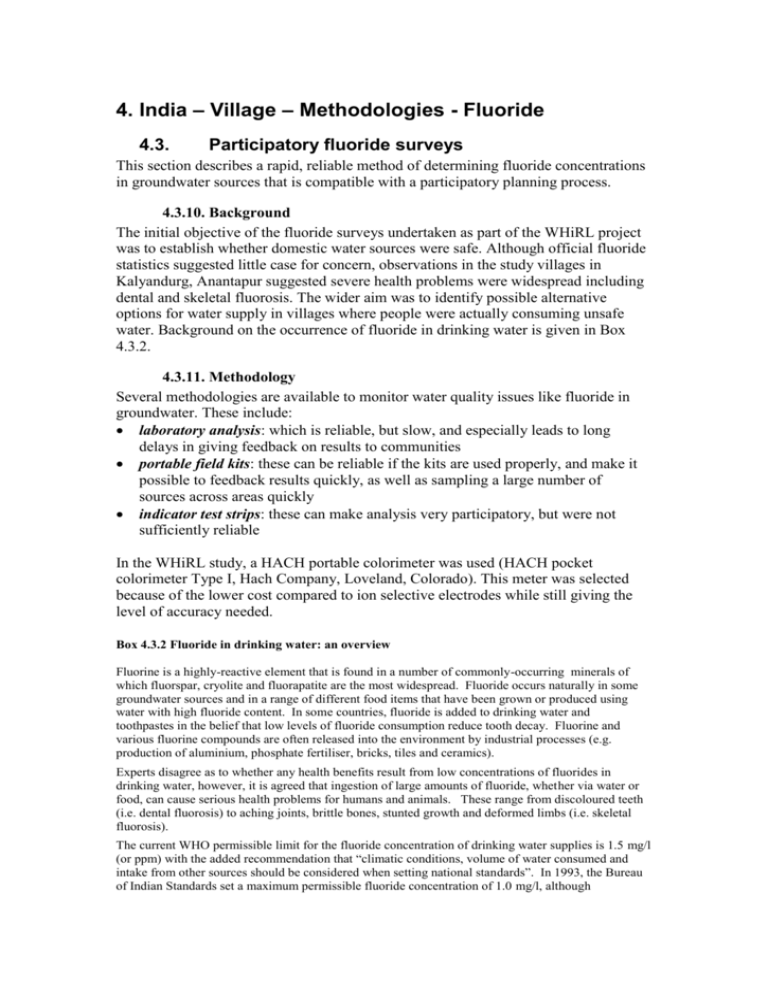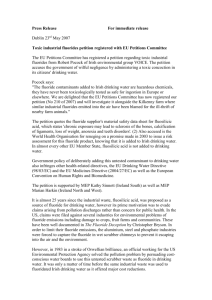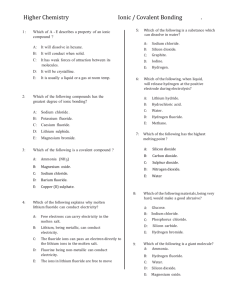Participatory fluoride surveys
advertisement

4. India – Village – Methodologies - Fluoride 4.3. Participatory fluoride surveys This section describes a rapid, reliable method of determining fluoride concentrations in groundwater sources that is compatible with a participatory planning process. 4.3.10. Background The initial objective of the fluoride surveys undertaken as part of the WHiRL project was to establish whether domestic water sources were safe. Although official fluoride statistics suggested little case for concern, observations in the study villages in Kalyandurg, Anantapur suggested severe health problems were widespread including dental and skeletal fluorosis. The wider aim was to identify possible alternative options for water supply in villages where people were actually consuming unsafe water. Background on the occurrence of fluoride in drinking water is given in Box 4.3.2. 4.3.11. Methodology Several methodologies are available to monitor water quality issues like fluoride in groundwater. These include: laboratory analysis: which is reliable, but slow, and especially leads to long delays in giving feedback on results to communities portable field kits: these can be reliable if the kits are used properly, and make it possible to feedback results quickly, as well as sampling a large number of sources across areas quickly indicator test strips: these can make analysis very participatory, but were not sufficiently reliable In the WHiRL study, a HACH portable colorimeter was used (HACH pocket colorimeter Type I, Hach Company, Loveland, Colorado). This meter was selected because of the lower cost compared to ion selective electrodes while still giving the level of accuracy needed. Box 4.3.2 Fluoride in drinking water: an overview Fluorine is a highly-reactive element that is found in a number of commonly-occurring minerals of which fluorspar, cryolite and fluorapatite are the most widespread. Fluoride occurs naturally in some groundwater sources and in a range of different food items that have been grown or produced using water with high fluoride content. In some countries, fluoride is added to drinking water and toothpastes in the belief that low levels of fluoride consumption reduce tooth decay. Fluorine and various fluorine compounds are often released into the environment by industrial processes (e.g. production of aluminium, phosphate fertiliser, bricks, tiles and ceramics). Experts disagree as to whether any health benefits result from low concentrations of fluorides in drinking water, however, it is agreed that ingestion of large amounts of fluoride, whether via water or food, can cause serious health problems for humans and animals. These range from discoloured teeth (i.e. dental fluorosis) to aching joints, brittle bones, stunted growth and deformed limbs (i.e. skeletal fluorosis). The current WHO permissible limit for the fluoride concentration of drinking water supplies is 1.5 mg/l (or ppm) with the added recommendation that “climatic conditions, volume of water consumed and intake from other sources should be considered when setting national standards”. In 1993, the Bureau of Indian Standards set a maximum permissible fluoride concentration of 1.0 mg/l, although concentrations of up to 1.5 mg/l are considered to be acceptable in the absence of an alternative safer source. Training and testing Samples were analysed using the manufacturers prescribed ‘pipette’ method. This requires use of standard fluoride solutions to calibrate the meter, and adding reagents to water samples, so a careful and experienced user is vital. Training to check the procedure recommended by the manufacturer, and to check results for consistency (by repeating tests) and reliability (by comparison with results from laboratories) should not be overlooked. Our testing period showed that we would also need to dilute samples with distilled water by a ratio of 2:1 in order to remain within the measurement limits of the equipment. Sampling In the vicinity of the four study villages (Battuvanipalli, Pathacheruvu, Mairevu and Obulapuram), water samples were collected from each well within approximately 2 km of the village centre. This included the main domestic water supply sources for the villages, but also other sources like irrigation wells in order to provide information on variations in fluoride levels around the villages and areas around the villages where better quality water might be available. A major factor in determining the timing of sampling was that we had to visit irrigation wells when power was available. Basic information on the type and use made of each well was also collected, and using a GPS system, the exact location was also logged. Occasional measurements were also made of surface water in tanks and check dams that are used to recharge groundwater. Analysis Samples were analysed using the colorimeter in a temporary laboratory, a clean room with space to layout the samples and equipment, usually on the same day as sample collection, either within the village or nearby. After solving problems revealed by the initial cross-checks (poor results due to procedure, dilution etc) it was possible to complete 10-15 tests in an hour. Calibrations of the portable meter were regularly checked against standard fluoride solutions, and samples sent to other laboratories for cross-comparison. The results of analysis using the portable colorimeter compared favourably with results from samples sent to water quality laboratories in nearby Kurnool and Anantapur. In fact, we believed the above method to be more reliable than some of the laboratory analyses: especially those determined using a visual assessment method. However, regular checking of different batches of samples over time, tests by different operators, and with different laboratories is important to reveal possible errors. It is useful to plot the field and laboratory results together in a scatter graph and to look for differences and patterns. In order to further triangulate the findings of the surveys, results were compared with results from a rapid assessment in 2001. In an earlier study (3.3 India-DistrictMethodologies-QPA) in Kalyandurg, water users had been asked in late 2001 to assess the quality of water from domestic sources on the basis of taste and whether they felt the water contained fluoride. Despite the differences in timing of sampling there was good agreement between these results and the results of fluoride analysis. For the 13 sources covered by both surveys, the fluoride values for the three sources ranked by users as having fluoride problems had contents of 1.47, 1.74 and 2.94 mg/l. For the other 10 sources not considered to have fluoride problems by users, results were all in the range 1.00 – 1.44 mg/l. Data analysis and discussion The WHiRL project had wider objectives to identify solutions to fluoride contamination of drinking water following a participatory planning process linked to implementation of watershed development in the study villages. Participation of the community in collecting water samples was encouraged, so that people understood the objectives of the survey and felt some level of ownership of the findings. Equally important, results were then rapidly reported back to the community and well owners. Wells where fluoride levels exceeded the safe limit of 1.5 mg/l (Table 4.3.3) were also marked with a red cross to indicate that the water was considered unsafe for drinking. After the initial survey, fluoride levels were again routinely measured, roughly once every two months, for the main domestic water sources and within areas (using the irrigation wells to collect groundwater samples) where it seemed possible to locate new safe drinking water sources. Table 4.3.3 Effects of fluoride in drinking water Fluoride in drinking water mg/l Below 1.0 1.0-1.5 1.5-3.0 3.0-10.0 Effects Safe Marginal High risk of dental fluorosis Leads to skeletal fluorosis with adverse changes in bones Crippling skeletal fluorosis More than 10.0 4.3.12. Example results The initial surveys revealed significant differences in fluoride levels both within and between the four villages studied (Table 4.3.4). Flouride levels were high in all villages, but on average are within safe drinking water limits (1.5 mg/l) in Manirevu and Obulapuram. Some sources in Battuvanipalli and Pathacheruvu by contrast had levels around 4 mg/l, and since health problems were also reported in these villages, later surveys focused on these two settlements. Table 4.3.4 Flouride levels in groundwater, October-November 2002 Habitation No of samples Battuvanipalli Manirevu Obulapuram Pathacheruvu 68 60 71 72 Minimum fluoride content (mg/l) 1.04 0.49 0.71 0.88 Maximum Average Std dev fluoride content fluoride content (mg/l) (mg/l) 4.28 2.6 0.86 2.42 1.3 0.39 1.82 1.4 0.23 3.96 2.1 0.56 Of the 26 mainly ‘domestic’ public water sources in the four villages, 10 had fluoride values above the recommended safe limit of 1.5 mg/l. The situation was most severe in Battuvanipalli where supply for the main piped system had high fluoride levels (2.94 mg/l). Other alternative sources here had other water quality problems: the water was brackish. Fluoride levels were also found to be a major problem in Pathacheruvu (the analysis here also includes some sources in nearby Golla village) where 5 out of 6 sources failed. None of sources in the hamlet of Pathacheruvu itself were safe, and the only safe source is located some distance away in Golla. The new source where the hamlet was to be resettled also had high levels (1.9 mg/l). In Manirevu and Obulapuram one handpump in each village exceeded the safe limits, but other safe sources were available. No statistical significant difference was found between fluoride levels for different well types (e.g. borewell, dugwell, dug-cum-borewell), and furthermore there was no statistically valid difference between values from drinking (average 1.6 mg/l) and irrigation sources (1.92 mg/l). Routine monitoring of fluoride levels showed that values fluctuated significantly during the year, and especially during drought periods. The extended period of drought (and falling groundwater levels) throughout 2003 and early 2004 led to an average increase in fluoride concentrations in observations wells of around 30%. This finding suggests that the impact of droughts can include severe water quality problems, and that similar increases in fluoride levels and health problems might be expected as a result of groundwater overexploitation (for irrigation) in these areas. 4.3.13. Use of findings The results of fluoride surveys were accepted readily by residents of Battuvanipalli and Pathacheruvu and the day after the surveys, people were busily exchanging results and had memorised most of them. They wanted information to understand why they were suffering health problems, and more importantly, so that they could find solutions. The interest in and acceptance of results contrasted starkly with the reaction from district-level authorities who stuck firmly to the official line that there was not a fluoride problem in these villages. It was only after approximately 12 months of interactions that these authorities started to accept the findings of the preliminary surveys and to recognise that people in these villages have been suffering because of the water quality of their drinking water supply. As part of the participatory planning process, ideas for solutions were developed. In Battuvanipalli for example, options included: Alternative source for drinking: Eight out of a total 65 irrigation wells sampled in the vicinity of Battuvanipalli recorded fluoride levels below 1.5 mg/l (in the range 1.04-1.46 mg/l). There was a cluster of wells about 2 km south of the village where a new source could be sited, however this area was disputed with a neighbouring village. Recharge of existing source and management: It was thought that enhanced recharge in the zone close to the existing well and management of water levels in the area (e.g. by restricting pumping from adjacent irrigation sources) might influence fluoride levels. Treatment: Given the existing good water supply, apart from very high fluoride levels, household or community level treatment of water was another option. Eventually, an irrigation well with low fluoride levels 1.5 mg/l (compared to the 3.8 mg/l of the existing source at this time) was used to develop a new drinking water supply for the village, in addition to the existing supply. The farmer who provided this well was compensated. 4.3.14. Lessons learnt The main findings and lessons learnt during the participatory fluoride surveys were that: cross-checking of results between different methods is valuable and essential a large variability in fluoride levels between different sources can be expected fluoride levels increased during a period of drought and similar impacts might be expected as a result of overexploitation of groundwater the wells with the best quality water may often being used for irrigation there were high levels of fluoride in some domestic water sources, and discrepancies with official statistics, but high levels were supported by health observations and community reports. Cross checking the results of water quality monitoring with health statistics, health observations, and community interviews should be more widely adopted, and a high-level of resistance from relevant district authorities can be expected if participatory surveys produce findings that do not support the official statistics. This resistance can be broken down over time but patience and sensitive interactions are required. Read more WHiRL. undated. Beware of fluoride in water. Briefing note, India No. 2. Accion Fraterna, Anantapur. References and links www.hach.com is the website of a popular manufacturer of water quality testing equipment, including the colorimeter used in this study. Hach have agents in India and other countries. Seeley, J. 2001. Recognising diversity: disability and rural livelihoods approaches in India. Natural Resource Perspectives, Number 72. ODI, London. Smith, M. D. 1999. Study of fluoride treatment. Consultancy Report (for proposed DFID-supported Andhra Pradesh Water and Environmental Sanitation Project). WEDC, Loughborough. van der Sommen, J. J., Gischler, M. A. and Krupanidhi, K. V. J. R. 1998. Monitoring of groundwater in fluoride-affected areas in Andhra Pradesh (India), in H. A. J. v. Lanen (editor), Monitoring for Groundwater Management in (semi-) arid regions. UNESCO, Paris.






